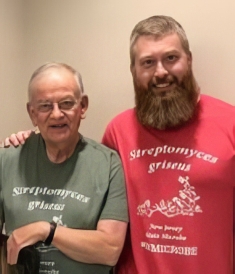Associated Professor Jeff Boyd and Distinguished Professor Emeritus Doug Eveleigh Quoted in Popular Science

In times of old, as legend goes, travelers wandering near a marsh would see the flicker of a light in the distance and confuse it with the glow of a candle from a far-away home. But there was no home and no candle. As they followed the glimmer into the wetland, the light would disappear—but not before the betrayed wanderers found themselves lost among the reeds, where many of them met their chilling end.
This fiery orb, typically seen above stagnant water, became personified in European folklore. Some historical accounts say it was considered a satanic sprite that wielded a fleeting wisp of fire, earning it the name 'Will with the wisp,' or will-o'-the-wisp. In other tales, it was the lost soul of a man named Jack. After being denied entry to the underworld, he haunted the night with a homemade light—a burning piece of coal inside a carved turnip—and became known as "Jack with the lantern," or jack-o'-lantern...
These real-life jack-o'-lanterns most likely occur when a blend of natural gas rises to the surface of a mire, says Jeff Boyd, a microbial biochemist at Rutgers University. Unlike oceans and lakes, bog water is stagnant and oxygen-deprived. This creates the perfect environment for anaerobic bacteria and archaea—microorganisms that live without oxygen—to thrive. And many of them belong to a group known as methanogens.
What exactly is a methanogen? "They make a living by eating dead plant material," Boyd says. "As they break it down, one of the byproducts can be methane gas—the same gas that people are fracking for. When it forms in anaerobic environments, it can get trapped underwater, only to be released by a physical disturbance"...
The first European settlers learned just how flammable bogs can be in what some consider the first American science experiment. In 1783, while George Washington waited in Princeton, New Jersey for the freshly-signed Treaty of Paris to arrive, he killed time with a debate: He argued with fellow revolutionary Thomas Paine and his soldiers about how these mysterious will o' the wisp flames (which were already well-documented at the time) formed. While Washington and Paine blamed natural gas for the eerie glow, some of his soldiers disagreed.
"To settle the argument, they decided to take a pontoon out on the swamp-like Millstone River," says Doug Eveleigh, an applied microbiologist at Rutgers. "They took long poles and probed the mud, while holding a flame above the river."
Moments later, a "great, big flash" erupted from the water, says Eveleigh, who reenacted the feat in 2008, to commemorate its 225th anniversary. "I believe it was the first real scientific American experiment."
Read the full article at Popular Science